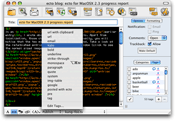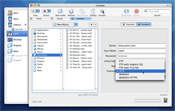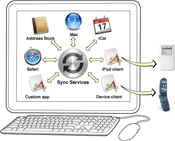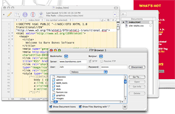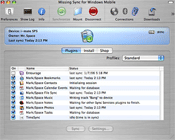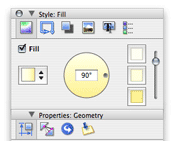Our Apple expert John C. Welch picks 22 lesser-known applications that can make your Mac experience more productive and more fun. Part 1 of 2.

This story originally appeared March 10, 2007.
|
|
|
|
While Mac OS X is a top-notch operating system, there always are things it can't do, or could do a bit better. This applies to every operating system, because if they were all perfect, then no one would make money writing third-party software! I know the Internet abounds with various lists of "Mac Software You Can't Live Without"; if you can stand one more, I've compiled what I've found to be some cool and useful tools. No, I don't think you can't live without any of them, but they've all made my Mac experience more complete, and a little more fun, too. One further word: Don't take the order below too seriously; it's more a reflection of how and when things occurred, rather than a definitive comment on relative merit.
22
Ecto
from Kuala Co. Ltd.

|
|
(click image for larger view) | |
|
Adriaan Tijsseling's blog posting application is one I use every day for the various blogs I post to, both out in public and in my "real" job. It is far and above better than anything that MovableType or WordPress have been able to come up with, and its flexibility in connecting to different blogging systems is one of its main strengths. The other reason I use and love Ecto is the flexibility it gives me. It allows me to write posts the way I want to, which is still rather behind the WYSIWYG curve. I do it all in plain text, and apply the tags manually. Ecto lets me set up custom tags however I like, and even grab clipboard data to enter in the tags. Makes adding long URLs a snap. It also lets me create tags that are custom to various blog systems, so that I'm not stuck with trying to remember far too many nonstandard tags. It's AppleScriptable (always a huge plus in my world), and it does what I want my apps to do...it makes my work noticeably easier and more pleasant.
21
Transmit
from Panic Software

|
|
(click image for larger view) | |
|
Yes, I know, using an FTP application isn't l33t, all the cool kids use the command line. OK, then, I'm not cool. But Transmit makes dealing with (S)FTP and the tasks I use FTP for smoother and easier. I love the split view, so that my FTP needs don't require multiple windows, either in the app or the Finder. (Yes, I love column view in the Finder, to the point that it's the only one I'll use.) It integrates with Sync Services and .Mac, so I can back up my favorites setting, and it gives me one-click integration with BBEdit, another application that I use nigh-continuously, (and yes, BBEdit's on the list, too). The only feature it's missing that I'd love to see is Kerberos support, but the Panic team has said it's coming soon. Even without that, it's the only FTP application on the Mac that works the way my brain does, and for that, I'll happily pay the thirty bucks.
20
Sync Services
part of Apple Mac OS X

|
|
(click image for larger view) | |
|
OK, Sync Services isn't technically an application, but it's my list, so there. While most people (incorrectly) call this iSync, Sync Services are a set of OS Services that allow for automatic data sharing and integration. The most visible use of this is iSync, for synchronizing contacts and calendar data to phones and PIMs, and .Mac sync, which allows you to sync things like bookmarks, calendars, keychains, Mail.app account data and others to your .Mac account.
However, that's the tip of the iceberg. What Sync Services does is allow any application that supports it to synchronize, well, any kind of data to any other application that uses this data. For example, the current version of Microsoft Entourage supports Sync Services for Notes, Contacts, Events, and Tasks. (You can choose Exchange or Local data for Contacts, Events, and Tasks.) However, iChat doesn't talk to Entourage, it talks to Address Book. Now, without Sync Services, I had to manually deal with this, and it was a pain. But with Entourage's Sync Services support, I don't have to mess with that. Any change I make in Entourage's address book is automatically synchronized with Apple's Address Book, or any other application that is Sync Services enabled and uses contact data. So instead of trying to make all applications use the same data source, they all just automatically share the same data in the format that is best for them.
When I use Missing Sync for Windows Mobile, from Mark/Space to synchronize my Windows Mobile phone to my Macbook, sure, it has an Entourage conduit, but I never use it. Missing Sync talks to Sync Services, too. Without Sync Services, you get into conduit hell. "Do I have a conduit for this device to talk to that application?" This is why Mac users who rely on Quicken are forced to use Treos. Pocket Quicken's Mac conduit is Palm only. If you want to use Windows Mobile, you have to sync with Windows. With Sync Services, the application never talks directly to the device. The device talks to Sync Services and the application(s) talk to Sync Services. So now, instead of synchronizing with an application, I'm only synchronizing data. It's really cool. Apple only supports Sync Services locally on your Mac, or remotely only to .Mac. However, Mark/Space recently released its SyncTogether application which extends Sync Services over your local network, or the Internet. Sync Services helped remove one of the single biggest headaches from my day, and that's why it's on the list.
19
BBEdit
from Bare Bones Software

|
|
(click image for larger view) | |
|
There are not a lot of applications that I'm a "fan" of. I'm normally willing to change applications without hesitation if I need to. But there are exceptions, and BBEdit is one of them. It is nominally a text editor, or a programmer's editor but, really, it's a text toolbox. If I'm not writing in BBEdit, it's because I am required to use something else, or it's a blog post, and I'm using Ecto. I mentioned that I like Transmit for its integration with BBEdit. That's because I don't think it's possible for me to get through a day without needing BBEdit. A short list of the features I use: Multifile searching (I mean entire directory trees with little to no effort), GREP support, language syntax support, html previews in any browser on my system or WebKit, amazing AppleScript support, on and on. Yes, I know, again, I can replicate everything BBedit does with the command line, or other editors and tools. But for my needs, why bother when BBedit gives me everything I could ever need or want in one package? A recent UI design managed to do that which so many other applications have failed at: It made the UI not just better, but easier and simpler to use. BBEdit got me through every programming or HTML class I've ever taken, and the library of searches I've built up over the years gives me rather astounding power in a fast, easy package. As long as Rich Siegel and all the other folks at Bare Bones keep working their mad BBEdit mojo, I'll keep buying it and using it.
18
Missing Sync for Windows Mobile
from Mark/Space

|
|
(click image for larger view) | |
|
I mentioned Missing Sync already, and with good reason. It's the best Windows Mobile to Mac OS sync software bar none. I will say that about their Palm product, and based on past experience, I'll say it about their upcoming BlackBerry product as well. It does exactly what I need, and doesn't throw me surprises along the way. The Sync Services integration means that I don't have to care about application conduits. It's been such a solid application that, at this point, I refuse to buy a non-iSync supported phone that isn't supported by Missing Sync, and given the choice, I'd happily pick Missing Sync over iSync any day of the week. Even if iSync were to support Windows Mobile devices, I'd stick with Missing Sync. It's good enough to beat free.
17
OmniGraffle Pro
from The Omni Group
ConceptDraw
from Computer Systems Odessa

|
|
(click image for larger view) | |
|
(Yes, I know, two products, but I don't think you can mention one without the other, and I use or have used both quite a bit.) One of the workhorse applications for IT people on Windows is Visio. I've been an off-and-on Visio user since version 4 on Windows 95, and it's consistently been one of those applications that I've really wanted on the Mac. Well, thanks to two products, ConceptDraw and OmniGraffle Pro, I don't really care as much about Visio anymore. Don't get me wrong, Visio was, and is still, a great product. But between ConceptDraw and OmniGraffle Pro, the need for Visio on the Mac has, for me at least, dropped rather low.
ConceptDraw is the most Visio–like of the two. If you're used to Visio and its ins and outs, then ConceptDraw is going to be the easier option. It's got more of a business and IT focus than OmniGraffle, and has the ability to automatically scan your network to create a diagram in the NetDiagrammer version. ConceptDraw is cross-platform, with versions that run on Windows and Mac OS X, so you see some design decisions that may not always be the most "Mac" way to do things, such as not using AppleScript in favor of its own cross-platform scripting language, some UI quirks that betray the task of serving two masters. So ConceptDraw is not the best Mac UI ever. However, if you have to deal with large, complex network diagrams, or need a diagramming tool that is at home on two platforms, ConceptDraw is a great product. I know I've never been disappointed with it.
OmniGraffle is an unabashedly Mac–only application. Written by one of the premier Cocoa programming teams on the planet, it takes advantage of every Mac OS X feature and adds a few of its own. It's beautiful and the diagrams it creates are beautiful as well. However, it's not just a pretty shell. OmniGraffle is a serious tool and can handle almost any diagramming task you throw at it. It just happens to be really pretty as well, and that's never a bad thing. Like ConceptDraw, it can handle Visio diagrams well (thanks to Visio wisely supporting an XML–based file format), and it can help you visualize your network in whatever manner you choose. As a good Mac application, it of course has a solid AppleScript implementation, which gives it a serious edge over ConceptDraw on the Mac. It's not as convenient as ConceptDraw in some ways (automated network diagrams, cross–platform), but if you're primarily a Mac user, you'll not be sorry you use OmniGraffle. That's the great thing about having a vibrant developer community that doesn't live in fear of Redmond: you get more cool toys, and for my needs, both ConceptDraw and OmniGraffle rule.
16
iChat AV
from Apple

Yes, I know, chat is supposedly the realm of kids and teens, and if IT does deign to use it, then you have to use MSN/Windows Messenger/Windows Live Messenger/Whatever Microsoft is calling it this week. Well, nuts to that. For any number of reasons, I run my network from a Macbook, and while I know the Mac BU puts a lot of work into the Mac version of Microsoft Messenger, it's really quite useless for me. For one, there's no A/V, (and yes, they did publish the reason for it up on Mac Mojo, and I think their logic for waiting on the AV features is sound. However, that doesn't change the fact that those are features I need, and none of them are in Microsoft Messenger. Secondly, and more important, everyone I need to IM with work-related matters isn't on Microsoft Messenger, they're all on iChat/AIM. So I could use Microsoft Messenger, but it would be of no use. (OK, yes, LCS, but I'm not going to pay that kind of tax just to get Microsoft Messenger to talk to AIM. Please.)
iChat also is scriptable, in a useful way. Microsoft Messenger has a scripting dictionary, but it's useless. Scripting is important to my work needs, because I eventually script, well, everything I use in some way or another.
The heart of it is, iChat is dead simple to use, and it just works. It talks to Sync Services, so keeping my buddy list straight is easy. It's dead simple to move files with it. It supports Jabber, so I can use it with Google Chat, or any one of dozens of services based on Jabber. The Bonjour abilities make using it in ad-hoc situations to shoot files around far easier than e-mail, and without the restrictions of 99% of e-mail servers. iChat has had no spam problems for me. None. Zero. Zip. So right there, it's automatically got a better S/N ratio than any e-mail service. Thanks to AIM's "forward to cell" service, I can respond to IM's on my phone if I wish as text messages.
The ease of chat/voice/video conferencing makes it a much nicer tool than e-mail or phones for getting multiple people to talk to each other, which makes for rather nice, low-overhead conference calls. My work-related chat usage has been climbing steadily for years, and iChat's just made that process easier. I could use something else, but why?
15
AppleScript
from Apple

|
|
(click image for larger view) | |
|
Long considered a hidden jewel in Apple's crown, AppleScript is enjoying yet another renaissance thanks to Automator, a rather nice GUI drag and drop UI for automation languages. While you can create Automator actions in many languages, AppleScript is the one that gives you the most access to not just Mac OS X, but also the applications on the Mac. AppleScript also is, as you delve into the community, kind of a schizophrenic issue for Apple. It has yet to ever give AppleScript the same kind of public support it's given Cocoa or other technologies, yet it's no lie or even exaggeration that the workflows created in AppleScript have saved Apple's bacon in many companies on multiple occasions.
I've seen, and helped write, serious, real-world scripts and applications in AppleScript that do serious, real-world work, along with thousands of others, yet AppleScript is truly the Rodney Dangerfield of programming. It gets no respect, probably because it breaks so many rules. It doesn't have a C-like syntax. It doesn't even have a BASIC-like syntax. In fact, you'd be hard pressed to find many languages that AppleScript does represent. It's not consistent. Keywords and constants can change depending on what you're doing. You can have AppleScript additions, aka OSAX, that add different features and change the language even more. (Lots of languages have add-ons, but they tend not to change the language itself.)
Part of the problem is that, as a standalone programming language, AppleScript just isn't that powerful. Where it shines is as a glue between applications. The idea of AppleScript is to take all these different applications you have on your Mac and tie them all together. If you have BBEdit, why would you need to have an extensive text handling library? If you have a scriptable e-mail client, why does AppleScript need to give you e-mail support?
I dislike language wars intensely, mostly because I have the opinion, shared by few, that any language that still requires typing shows the essential failure of the computer industry to pry programming out of the hands of geeks. However, that prejudice aside, I love AppleScript. It is one of the tools I use so often that I cannot imagine working on a platform without it. I've used it to script almost every task I have to do more than once in a while, for everything from translating e-mails to blog posts, to software updates via Apple Remote Desktop, to configuration changes to creating structured PDFs from Microsoft Entourage e-mails to...well, it's just my problem-solving tool of choice, because it lets me use all the tools at my disposal, not just the ones it happens to provide me.
14
Script Debugger
from Late Night Software

|
|
(click image for larger view) | |
|
As I mentioned (in number 15), AppleScript is a huge part of what I do in my professional life. Well, there's another part. Apple provides you with some solid tools, for creating basic scripts and full-on Cocoa applications, with a proper GUI and everything. However, I'm an IT person, I don't need GUIs too often, and I left the "basic" script behind years ago. However, there is a tool that was written for me. OK, not literally, but it may as well have been: Script Debugger. I can say with full confidence that there has not been a script I've written in almost 10 years that hasn't been made not only easier to write, but better, thanks to Script Debugger.
In this era of "meta" IDEs like Eclipse, and even Xcode, that try to be the one tool for all your programming needs, in every language possible, Script Debugger is the other end. It's designed for one thing: AppleScript. (Well, two really: Late Night has a JavaScript scripting addition that lets you use that language instead of AppleScript, and it's free.) To that end, it's the best AppleScript IDE available, and that includes AppleScript Studio, the Xcode AppleScript feature set. It may not be able to build GUIs (although since Late Night bought FaceSpan, that could change in the future), but when you need to really get in there and bang out complicated code, there is nothing, and I mean, nothing in the AppleScript universe that will be of more use to you than Script Debugger.
It has astounding debugging facilities that I'd happily pay far more for than the paltry $200 U.S. Script Debugger goes for, or the $99 U.S. for upgrades. It has a live dictionary display. Now, in AppleScript, the dictionary is the center of your universe, so any tool that lets you understand an application's dictionary better is always welcome. Script Debugger lets you view that dictionary live. That is, not just a static series of entries, but as it applies to an application while it's running. Want to see where Microsoft Word stores Table of Contents info? Script Debugger will show you with the actual document data.
I could, quite literally, spend pages talking about all the ways Script Debugger has made what seemed like impossible tasks not just possible, but in some cases, easy. Instead I'll say this: If you want to get serious about AppleScript, go and download the demo. I know for my part, if I couldn't use Script Debugger, I'd probably stop using AppleScript.
13
Microsoft Entourage
from Microsoft's Macintosh Business Unit

Yes, I know, none of the cool Mac kids like Entourage. Well, OK, but I wouldn't be half as productive without it, and that was before I worked in an Exchange shop. I also realize that Entourage isn't as good an Exchange client as Outlook on Windows, or even Outlook 2001 for Mac OS 9 was. With regard to the former, well, that will always be. There are parts of Outlook's functionality that simply require Windows. With regard to the latter, I say "True...yet."
One of the great things about not being a cool kid is that I don't have to subscribe to the cool kid orthodoxy. The truth about Entourage's Exchange support is that it regularly gets better. From Entourage v.X to 2004's release to 2004 SR 2, Entourage gets better every time in relation to Exchange. I'll bet with complete confidence that Entourage 2008 will be not just a little better, but a lot better than 2004. But then, the Mac BU is like that.
I've never liked the whole idea of having separate applications for everything. I can't work well when related data is all over the place in different UIs, with only vague links between them. Entourage has, from the first day I got my grubby mitts on it, worked the way I like to work. There's some things it doesn't do the way I'd like it to, but that's maybe 5% of what I care about. The rest? Golden, absolutely golden. Of course, the AppleScript support in Entourage is a huge part of that. While Mail and the other Apple applications were barely scriptable, I was writing Entourage scripts that let me get real work done. I've tried to deal with other applications, but kept coming back to Entourage because of the work that it would require in those applications just to get close to where I already was with Entourage.
Entourage tends to create binary reactions, people either love it or hate it. Me, I'm firmly on the "1" side of that bit, and happily so.
12
SketchFighter 4000 Alpha
from Ambrosia Software

Man does not live by work alone, nor do IT people. There are times when I like to be reminded that a computer can, occasionally, just be fun. For that, I have SketchFighter. I admit that I have a particular fondness for this game because it's based on the kinds of things I did as a kid in junior high when I should have been paying attention to anything else.
However, outside of that, it's really just a fun game. No need for strategy guides, no secret keystrokes, etc. You can go from launch to playing in under a minute on a MacBook Pro. It has network play, level editors, you name it. The controls are so simple that you don't need a template.
I am known by my friends for being a huge Neverwinter Nights fan, but I play the heck out of SketchFighter. It doesn't contribute a single thing to my productivity beyond giving me a reason to not hate computers. For an IT person, that can be rather important.
11
TypeIt4Me
from Ettore Software

As you can tell by the length of this, I type a lot. I've a good speed, and my mother, a former legal secretary, taught me how to do it correctly on an IBM Selectric. I've been typing a long time. However, no one likes to type the same thing over and over and over again. For that kind of monkeywork, I have TypeIt4Me. Its job is as an abbreviation expander. So, I type "Tiger" and I get Mac OS X 10.4. It's case-sensitive, so when I type "tiger" I get tiger. "mosx" gives me Mac OS X. "mosxs" gets me Mac OS X Server. You get the idea.
This is a product that I literally don't think about until I get on a system that doesn't have it. Then I miss it. I miss it like a missing thing that's missed. It's that handy and useful. Ricardo Ettore, the genius behind TypeIt4Me has, through the years, resisted the temptations of "featureitis", so TypeIt4Me still is a lean little dear of a utility. One new feature he did add was the ability to launch AppleScripts via abbreviations. So now you can use TypeIt4Me to do...well, almost anything you can do with AppleScript, and that, dear reader, is almost anything on a Mac. If you type a lot and you aren't using TypeIt4Me, you're wasting more effort than you know.
See the rest of John C. Welch's list of Top Mac OS X products in Part 2.
About the Author(s)
You May Also Like


